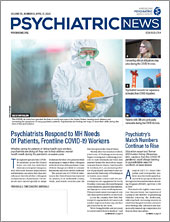Interest in psychedelic agents for the treatment of psychiatric disorders continues to grow. Even the Food and Drug Administration (FDA) has taken notice: Over the past couple of years, the agency gave breakthrough drug status to psilocybin (magic mushrooms) and 3,4-methylenedioxymethamphetamine (MDMA or ecstasy) for the treatment of depression and posttraumatic stress disorder (PTSD), respectively. Such a designation is meant to expedite the development and review of drugs that are intended to treat a serious condition.
To help psychiatrists and other mental health professionals navigate this emerging field, APA’s Work Group on Biomarkers and Novel Treatments (a component of APA’s Council on Research) published a detailed report on the clinical application of psychedelic drugs in psychiatric disorders in AJP in Advance. The review includes a rundown of the pharmacology of four psychedelic agents—MDMA, psilocybin, lysergic acid diethylamide (LSD), and ayahuasca—and describes studies that have examined the effectiveness of these drugs in the treatment of mood disorders, substance use disorders, and more. The review also offers suggestions on how psychedelic research should proceed.
“If you grew up in the 1970s like me when psychedelics were criminalized and maligned, you could easily dismiss the medical potential of psychedelics,” said William McDonald, M.D., the J. B. Fuqua Chair for Late-Life Depression at Emory University and a member of the APA work group. “But there is a wealth of data on these agents, and the research with MDMA and psilocybin is particularly exciting.”
As noted in the report, there have been placebo-controlled trials demonstrating the efficacy of MDMA in treating patients with PTSD and of psilocybin for depression and cancer-related anxiety. The evidence for LSD and ayahuasca—which have both been tested as treatments for depression and anxiety—is still preliminary.
Both McDonald and fellow report author Colin Reiff, M.D., a clinical assistant professor of psychiatry at New York University Langone Health, stressed that the APA work group was not advocating any clinical use of these substances. “But the evidence is strong enough that we are ready to move beyond small studies funded by private groups or philanthropy,” Reiff said. “This field needs National Institutes of Health [NIH] support.”
The Drug Enforcement Administration (DEA) classifies ayahuasca, LSD, MDMA, and psilocybin as Schedule I substances—a category that reflects a lack of accepted medical use and potential for abuse. This classification hinders clinical studies with these drugs. Researchers first need approval from both the DEA and their institution before they can conduct research with Schedule I drugs. Those lucky enough to get a license then must secure funding, which is scarce at the federal level. Since psychedelics are classified as drugs of abuse, agencies like NIH generally limit clinical funding to studies related to their abuse potential.
“Research has been [additionally] hampered by the fact that there is not a rigorous definition of psychedelic-assisted psychotherapy and the fact that the expectations and personal experiences of the study subjects are important variables in the response to psychedelic-assisted therapy,” the work group noted in the report. “These variables can be difficult to account for in a clinical trial, but they should be a part of the future research agenda.”
“What would be helpful in the near future is an international symposium focused on psychedelic research, so everyone can compare notes and set shared priorities moving forward,” Reiff suggested. McDonald also suggested that the National Institute of Mental Health or National Institute on Drug Abuse host a small symposium where they could lay out what they expect in order for researchers to obtain federal funding. ■
“Psychedelics and Psychedelic-Assisted Psychotherapy” is posted
here.

